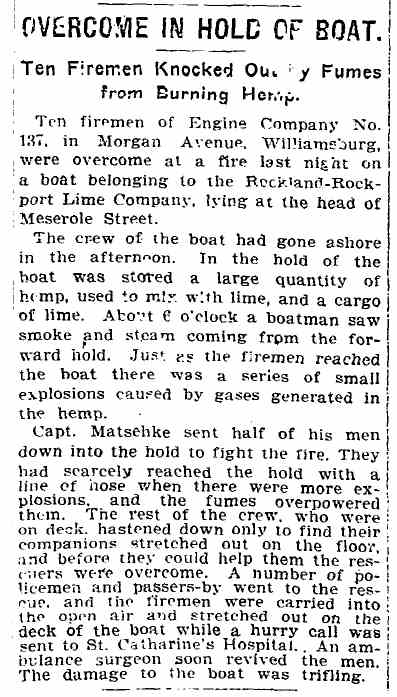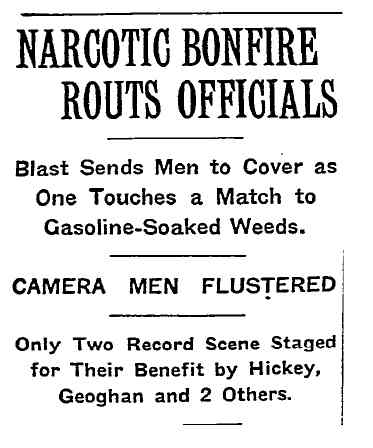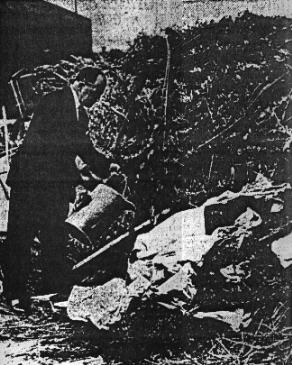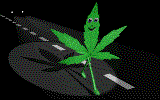
|
 |

|
|---|
ODD’S & END’S
From the Antique Andy’s -- "Believe it or Nuts" --- Collection
Antique Andy’s - "Believe it or Nuts"
Monkeys On A Hemp Farm

New York Times - June 13, 1887 p2
Monkey Labor in Kentucky Hemp Fields; R.O. - Willis's Letter to The Times
“Strange If True” - To the Editor of the New-York Times:
The hemp raisers in this vicinity now successfully employ monkey labor in competition with that of the negro. Perkins & Chrisman have a force of 11 large monkeys of the semi-gorilla species found near Cape Town, South Africa. Smith * Murphy have about 26. J.B. Parks, near Kingston, Ky., who introduced monkey labor into the hemp fields of Kentucky, has now a force of 17. James Guthrie, of Shelbyville, Ky., has 12. Other less extensive planters have from two to five each. They do the work better than the negro, and at one-fourth of the cost; they are taught very easily, as they are intelligent, docile, and even affectionate. The cost of the monkeys on an average is about $60 each. They are brought direct from Cape Town, South Africa, to Pensacola, Fla., and from there to Lexington, where they are distributed throughout the hemp fields. Hemp raising with this new species of cheap labor is decidedly profitable, which is not the case with free labor. The negroes do not like the appearance of things, and many of them say that either they or the monkeys will “have to go.” R.O. Willis, Danville, Ky., Tuesday, June 7, 1887.
New York Times - Feb. 17, 1887 p4
SCAB Monkeys
Loyal Knights of Labor Should View . . . arm and resist with clubs the movement . . . introduce imported monkey labor in this republic. . . . The man who has aimed this dastardly blow to organized labor is J. B. Parkes, of Kingston, Ky., who “has successfully trained seven large monkeys to work in his hemp field and brake and prepare the hemp for market.” The animals not only do the work to the perfect satisfaction of their shameless employer, . . . at about one-fourth the cost of negro labor. This is a small beginning, but it is fraught with all the perils of a crevasse in a Mississippi levee. The cruel laws of political economy will favor the extension of the plan, for the cheapness of monkey labor as compared with human labor must weight powerfully in favor of the former. Already this Parkers has sent to his brother in South Africa for ten more large monkeys. . . . have millions of pauper monkeys in this country, working merely for their board and . . . and excluding an equal or greater number of Italians and Irishmen from gainful occupations. This must not be; the . . . must go.
All the objections that the swift reasoning powers and instincts of the hoodlum . . . discovered and urged against cheap Chinese labor apply with tenfold force to . . . case of the monkey. And there are other rounds of objection which are peculiar to, and , so to speak, inherent in monkeys. . . He wears nothing but his hair, and is only in the slightest degree a consumer . . . . .A delegation of Knights of Labor should proceed at once to Kingston, where they should hang these seven scab monkeys with their own hemp, put the miserable Parkers under the ban of a perpetual boycott, and . . . such a letter of warning to his . . . brother in South Africa as would cause him to abandon forthwith his abhorrent . . . as a monkey purveyor.
New York Times - Feb. 17, 1887 p1
MONKEYS TO BE BOYCOTTED
Richmond Ky., Feb. 16.-- J.B. Parkes, a substantial farmer living near Kingston, Madison country, has successfully trained a force of seven large monkeys to work in his hemp fields, and to break and prepare the hemp for market. They do the work more quickly and better than the negroes he formerly employed, and at about one-fourth the cost. It required about four months of patient work to train the animals, but they now do their tasks with rare intelligence. The monkeys were sent to Mr. Parkes by a brother, who is in business in cape Town, South Africa, and who had seen the animals put to similar uses there. Mr. Parkes has sent for 10 more of the useful imitators of human workmen, six of them to be used by John G. Taylor, a neighboring farmer, who is also an extensive raiser of hemp.
New York Times- Aug 1, 1887 p2
“Monkeys On A Hemp Farm”
[From the London Truth.] A Rio Janeiro Journal Announces that on a large hemp farm in Brazil 20 monkeys have been taught to cut the hemp and prepare it for sale. It is added that the animals are preferred to negroes, because they work much faster and the cost of feeding them is trifling

Antique Andy’s - "Believe it or Nuts"
CARGO SHIP FULL OF MARIHUANA CACHES ON FIRE

OVERCOME IN HOLD OF BOAT
Ten Firemen Knocked Out By Fumes From Burning Hemp
Ten firemen of Engine company No. 137 in Morgan Avenue, Williamsburg, were overcome at a fire last night on a boat belonging to the Rockland-Rockport Lime Company lying at the head of Meserole Street.
The crew of the boat had gone ashore in the afternoon. In the hold of the boat was stored a large quantity of hemp, used to mix with lime, and a cargo of lime. About 6 o’clock a boatman saw smoke and steam coming from the forward hold. Just as the firemen reached the boat there was a series of small explosions caused by gases generated in the hemp.
Capt. Matsehke sent half of his men down into the hold to fight the fire. They had scarcely reached the hold with a line of hose when there were more explosions, and the fumes overpowered them. The rest of the crew, who were on deck, hastened down only to find their companions stretched out on the floor and before they could help them the rescuers were overcome. A number of policemen and passer-by went to the rescue, and the firemen were carried into the open air and stretched out on the deck of the boat while a hurry call was sent to St. Catharine’s Hospital. An ambulance surgeon soon revived the men. The damage to the boat was trifling.
Antique Andy’s - "Believe it or Nuts"
A NEW YORK BONFIRE GOES BAD -- REAL BAD
- THE NARC'S, EVERYONE ELSE, RUNS FOR IT.
FROM THE PAGES OF THE NEW YORK TIMES
[Oct. 19, 1934 p5] - “NARCOTIC BONFIRE ROUTS OFFICIALS”

“NARCOTIC BONFIRE ROUTS OFFICIALS”
Blast Sends Men to Cover as One Touches a Match to Gasoline-Soaked Weeds.
CAMERA MEN FLUSTERED
Only Two Record Scenes Staged for Their Benefit by Hickey, Geoghan and 2 Others
Two police officials and two prosecutors of New York City narrowly escaped being burned yesterday afternoon while doing a good turn for newsreel camera men and newspaper photographers during the ceremonious burning of a field of mariajuana in the rear of a tenement house at 189 Washington Street, Brooklyn.
The police took possession of the plot, almost an acre in size and bearing about half a ton of the narcotic weed, Wednesday afternoon after two detectives of the narcotic squad had raided a room at 17 Concord Street, near by, and arrested two men charged with the sale and possession of the plant.
Yesterday afternoon at 4 o'clock Police Emergency Squad 13 under Sergeant George Nadler had finished the work of tearing up the roots of the plants and arranging the brush in several stacks about three feet high and ten feet across, and everything was ready for the ceremony of sending $50,000 worth of the weed, the estimated value of the crop, up in smoke.
Pose Around the Pyre.
Several police officials, District Attorney William F. X. Geoghan of Kings County and United States Attorney Leo Hickey of the Eastern district had come to watch the bonfires, and the photographers asked them to stand around one of the larger stacks as it was set afire.
Following the directions of the photographers, Mr. Geoghan, Mr. Hickey, Fifth Deputy Police Commissioner Martin H. Meaney and Captain Joseph Mooney, commander of the narcotic squad, assembled around the stack.
Mr. Geoghan was told to light the fire. With five newsreel cameras and a dozen hand cameras trained on the scene from the ground and from fire-escapes, he struck a match and lowered it to the base of the stack, which had been saturated with gasoline.
The result was a loud explosion and a blast of fire that rocked the four men back on their heels and so startled the newspaper photographers that only two of them remembered to click their shutters. The four officials jumped out of the way just in time.
Scene is Re-enacted
All were visibly shaken by the experience, but the photographers were not to be denied. As the flames went shooting skyward the photographers tried to reassure their routed subjects, and finally succeeded in persuading Mr. Geoghan to return to the business at hand.
He lighted another match and, advancing warily, set fire to another stack as cameras clicked on all sides.
Members of the emergency squad then went to the task of burning the remainder of the brush, while some of their number stood by with fire extinguishers and two firemen watched from an adjoining roof with a high-pressure hose in their hands.
The field is surrounded on all sides by tenement houses. Windows and fire escapes served as vantage points for the occupants as they watched the show in their back-yard.
The men arrested at the Concord Street address, Nicholas DeCooms, alias Robert Arnold, and Louis Kelly, were held without bail for a hearing next Thursday when arraigned in downtown court for violation of the State Uniform Narcotic Act. Both were held in the Raymond Street Jail.

* NOTE: This picture was actually taken two years AFTER the event in question. We were not able to obtain an actual photo from the event, but this one looks about right.
AH NEW YORK , you've done us all proud!
WANT TO KNOW MORE:
=====================
Due to space / download time considerations, only selected materials are displayed. If you would like to obtain more information, feel free to contact the museum. All our material is available (at cost) on CD-Rom format.
CONTACT PAGE
NEW YORK STATE BACK TO MAIN INDEX |